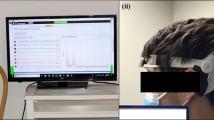Abstract
A quantitative EEG study in volunteer adults was undertaken to distinguish single oral administrations of 50 and 100 mg amobarbital, 10 mg dextroamphetamine, 40 mg fenfluramine and placebo. Four hour EEG recordings were monitored by frequent auditory reaction time tasks. The EEG changes were measured by digital computer period analysis.
In the analysis, each drug was distinguished from placebo, and from each other, with the best discriminations for 50 mg amobarbital and dextroamphetamine, and the poorest discrimination of fenfluramine from 50 mg amobarbital.
These observations are consistent with the clinical pharmacology of the compounds and suggest further applications of quantitative EEG for the classification of psychoactive drugs.
Similar content being viewed by others
References
Alphin, R. S., Funderburk, W. H., Ward, J. W.: Anorexigenic activity of n-Ethyl-α-Methyl-3-Trifluoromethylphenethylamine-HCl (AHR-965), a non-CNS stimulant. Toxicol. appl. Pharmacol. 6, 340 (1964).
Bacon, G. E., Lowry, G. H.: A clinical trial of fenfluramine in obese children. Curr. ther. Res. 9, 626–630 (1967).
Brodbin, P., O'Connor, C. A.: A double-blind clinical trial of an appetite depressant, fenfluramine, in general practice. Practitioner 198, 707–710 (1967).
Colmore, J. P., Moore, J. D.: Fenfluramine, an amphetamine-like appetite suppressant with paradoxical central nervous system and cardiovascular effects. J. New Drugs 6, 123 (1966) (abstract).
Elliott, B. W.: A collaborative investigation of fenfluramine: anorexigenic with sedative properties. Curr. ther. Res. 12, 502–515 (1970).
Fink, M.: EEG and human psychopharmacology. (Abstracts of Proceedings of Symposium at Third World Congress of Psychiatry, Montreal, 1961). Electroenceph. clin. Neurophysiol. 15, 133–137 (1963).
—: EEG and human psychopharmacology. Ann. Rev. Pharmacol. 9, 241–258 (1969a).
—: The human electroencephalogram: Index of clinical activity of new psychoactive agents. Mod. Probl. Pharmacopsychiat. 2, 106–110 (1969b).
—, Itil, T.: EEG analyses by digital computer: Relation of Pentothal induced changes to resting pattern. Electroenceph. clin. Neurophysiol. 18, 520–521 (1965).
—, Itil, T. M., Zaks, A., Freedman, A. M.: EEG patterns of cyclazocine, a narcotic antagonist. In: Neurophysiological and behavioral aspects of psychotropic drugs, pp. 62–71. A. G. Karczmar and W. P. Koella (Eds.). Springfield, Ill.: Ch. C. Thomas 1969.
— —, Hickman, C., Itil, T.: Quantitative analysis of the electroencephalogram by digital computer methods. III: Applications to psychopharmacology. In: Computers and electronic devices in psychiatry, pp. 109–123. N. S. Kline and E. Laska (Eds.). New York: Grune & Stratton 1968.
- Shapiro, D., Itil, T., Hickman, C.: Discrimination of amobarbital effects by quantitative electroencephalography. Psychiat. Res. Fdn. Mo. (St. Louis), 65/5 (1965).
Firth, H., Lewis, S. A., Ogunremi, O. O., Oswald, I.: The effect of acute administration of (meta-trifluoromethylphenyl)-1-(benzoyloxy)-ethylamino-2-propane (780SE) and fenfluramine on human sleep. Brit. J. Pharmacol. 39, 462–463 (1970).
Foxwell, M., Funderburk, W. H., Ward, J. W.: Comparative effects of fenfluramine and d-amphetamine on the CNS. Pharmacol. 9, 244 (1967) (abstract).
— — —: Studies on the site of action of a new anoretic agent, fenfluramine. J. Pharmacol. exp. Ther. 165, 60–70 (1969).
Gaind, R.: Fenfluramine (Ponderax) in the treatment of obese psychiatric outpatients. Brit. J. Psychiat. 115, 963–964 (1969).
Goldman, D.: Electroencephalographic manifestations associated with psychotic illness: Pentothal activation technique and pharmacologic interrelationships. Comprehens. Psychiat. 5, 80–92 (1964).
Hadler, A. J.: Fenfluramine, a new anorexigenic agent. J. clin. Pharm. 11, 52–55 (1971).
Hill, R. C., Turner, P.: Fenfluramine and critical flicker frequency. J. Pharm. Pharmacol. 19, 337–338 (1967).
Itil, T.: Elektroencephalographische Studien bei Psychosen und psychotropen Medikamenten. Monograph. Istanbul: Ahmet Sait Matbaasi 1964.
Itil, T. M.: Fenfluramine, reaction time—an interim report. Filed Report, A. H. Robins, July 12, 1968.
Johnson, D. N., Funderburk, W. H., Ward, J. W.: Effects of fenfluramine on sleepwakefulness in cats. Psychopharmacologia (Berl.) (in press).
Lawson, A. A., Strong, J. A., Roscoe, P., Gibson, A., Peattie, P.: Comparison of fenfluramine and metformin in treatment of obesity. Lancet 1970, 437–441.
Lewis, S. A.: Comparative effects of some amphetamine derivatives on human sleep. In: Amphetamines and related compounds, pp. 873–888. E. Costa and S. Garattini (Eds.). New York: Raven Press 1970.
Munro, J. F., Seaton, D. A., Duncan, L. J. P.: Treatment of refractory obesity with fenfluramine. Brit. med. J. 1966II, 624–625.
Oswald, I., Jones, H. S., Mannerheim, J. E.: Effects of two slimming drugs on sleep. Brit. med. J. 1968I, 796–799.
Raich, W. A., Rickels, K., Raab, E.: A double-blind evaluation of fenfluramine in anxious somatizing neurotic medical clinic patients. Curr. ther. Res. 8, 31–33 (1966).
Shagass, C., Jones, A. L.: A neurophysiological test for psychiatric diagnosis: Results in 750 patients. Amer. J. Psychiat. 114, 1002–1010 (1958).
Shapiro, D. M., Fink, M.: Quantitative analysis of the electroencephalogram by digital computer methods. Psych. Res. Fdn. (St. Louis) 66/1 (1966).
Simeon, J., Spero, M., Fink, M.: Clinical and EEG studies of doxepin: interim report. Psychosomatics 10, 14–17 (1969).
Volavka, J. V., Joyce, C. R. B., Maloney, M. J., Brawn, W., Summerfield, J., Topham, C., Scott, D. F.: Effect of nitrazepam amylobarbitone sodium and placebo on the elctroencephalogram of normal subjects. Psychopharmacologia (Berl.) 14, 178–183 (1969).
Ziance, R., Kinnard, W. J.: Some effects of fenfluramine HCl on the central nervous system. Pharmacol. 9, 244 (1967) (abstract).
Author information
Authors and Affiliations
Additional information
Aided, in part, by USPHS grants MH-11358, 13003 and 13358; the Psychiatric Research Foundation of Missouri, Smith Kline and French Laboratories and A. H. Robins, Inc.
This report summarizes data of a second quantitative EEG study undertaken in 1965–1966. Earlier progress reports dated April 1965 and May 1967 are available.
The cooperation of Connie Hickman, B.S.E.E. and the nursing and technical staff of the Missouri Institute of Psychiatry are gratefully acknowledged.
Rights and permissions
About this article
Cite this article
Fink, M., Shapiro, D.M. & Itil, T.M. EEG profiles of fenfluramine, amobarbital and dextroamphetamine in normal volunteers. Psychopharmacologia 22, 369–383 (1971). https://doi.org/10.1007/BF00406875
Received:
Issue Date:
DOI: https://doi.org/10.1007/BF00406875




